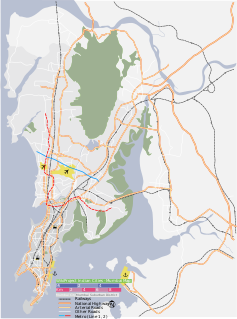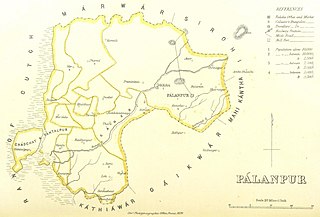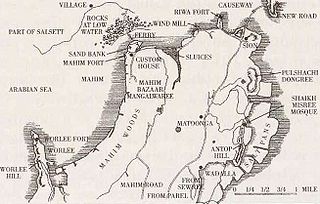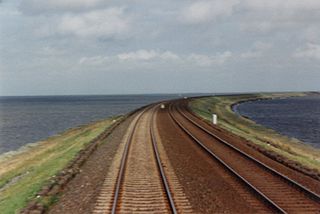
Mahim is a neighbourhood in Mumbai, India. The Mahim railway station is in the Mahim area, on the Mumbai suburban railway on the Western Railway line. Mahim is often considered as the heart of Mumbai. Mahim upholds the values of secularism and diversity. In fact one finds a temple, church, mosque and firetemple existing with few meters of each other

Colaba or Kulābā is a part of the city of Mumbai, India, and also a Lok Sabha constituency. During Portuguese rule in the 16th century, the island was known as Candil. After the British took over the island in the late 17th century, it was known as Colio.

Salsette Island (Salsete) is an island in the state of Maharashtra on India's west coast. The metropolis of Mumbai and the city of Thane lie on it, making it very populous and one of the most densely populated islands in the world. It has about 15.1 million inhabitants living on an area of about 619 km².

The Mahim Causeway is a vital link road connecting South Mumbai with its northern suburbs. The causeway links the neighbourhoods of Mahim to the south with Bandra to the north.

Palanpur Agency, also spelled Pahlunpore Agency, was a political agency or collection of princely states in British India, within the Gujarat Division of Bombay Presidency. In 1933, the native states of the Mahi Kantha Agency, except for Danta, were included in the Western India States Agency. The agency, headquartered at Palanpur, oversaw some 17 princely states and estates in the area, encompassing an area of 6393 square miles (16,558 km²) and a population, in 1901, of 467,271.
Kankrej thana or Kankrej Estates was a former collection of native states in what is now part of Banaskantha district of Gujarat, India.

Colaba Causeway, officially known as Shahid Bhagat Singh Road, is a commercial street, and a major causeway or land link between Colaba and the Old Woman's Island in the city of Mumbai, India.
Human habitation of Mumbai existed since the Stone Age, the Kolis were the earliest known settlers of the islands. The Maurya Empire gained control of the islands during the 3rd century BCE and transformed it into a centre of Buddhist culture and religion. Later, between the 2nd century BCE and 9th century CE, the islands came under the control of successive indigenous dynasties: Satavahanas, Abhiras, Vakatakas, Kalachuris, Konkan Mauryas, Chalukyas and Rashtrakutas, before being ruled by the Silharas from 810 to 1260.
Bombay, now called Mumbai, Bombaim in Portuguese, is the financial and commercial capital of India and one of the most populous cities in the world.

Sion Causeway is a major causeway in Bombay, India which connects Sion in Bombay with Kurla in Salsette. The construction of the causeway began in 1798 and was completed in 1805 by Jonathan Duncan, Governor of Bombay (1795–1811), at a cost of £5,037. In 1826, its breadth was doubled and improved at a further outlay of £4,000 A volcanic tract extends from Carnac Bunder to Sion Causeway, and forms the entire of the chain of hills bordering the north-eastenn end of the island from the Sewri Fort to Sion.

Chotila is a Hindu temple town and Taluka headquarters of Chotila Taluka, Surendranagar district, located near Rajkot, Gujarat, India.
Akadia or Ankadia is a village and former Rajput petty princely state on Saurashtra peninsula.
(Bhalgam) Baldhoi is a village and former non-salute princely state in Gujarat, western India.
Bhadli is a village and former princely state on Saurashtra peninsula in Gujarat, western India.
Bhadvana is a village in Lakhtar Taluka of Surendranagar district, Gujarat, India. It is situated about twelve miles north east of Wadhwan station and about five miles south of Lakhtar railway station.
During the British Raj period, Bhalala State, in the present-day Indian state of Gujarat, was a non-salute princely state and was governed by members of a Jhala dynasty.
Chachana is a village and former Rajput princely state in Chuda Taluka of Surendranagar district, on the Saurashtra peninsula in Gujarat, India.
Chok is a village in Jesar Taluka of Bhavnagar district, Gujarat, India. It is a former petty Rajput princely state.
Charkha is a village in Dhari Taluka of Amreli district on Saurashtra peninsula in Gujarat, western India. It was formerly minor princely state.
Bhojavadar is a village and former Rajput princely state Umrala Taluka of Bhavnagar district, Gujarat, India.








